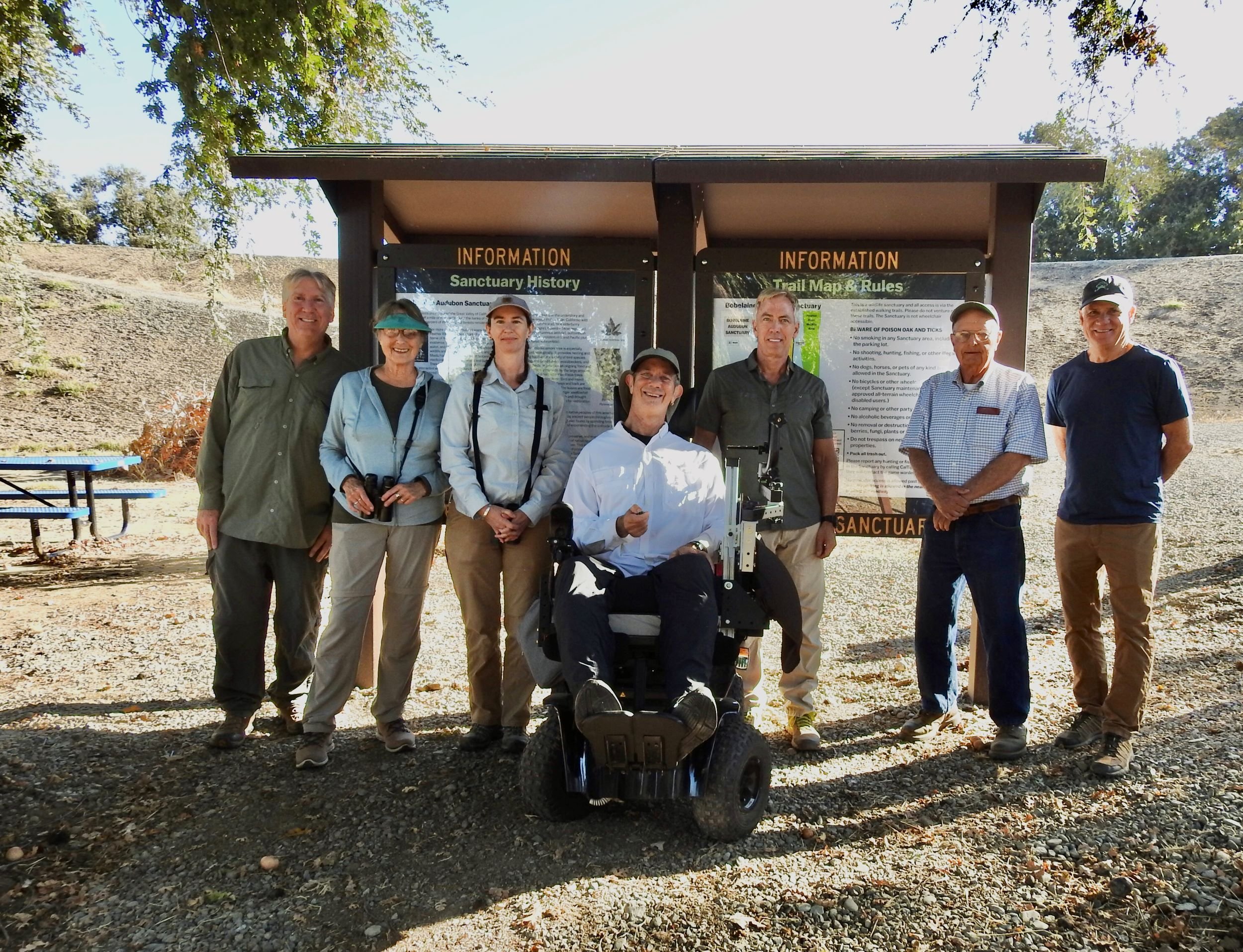Pictured in front of the new Kiosk at Bobelaine: John Williams, Maureen Geiger, Carla Resnick, Paul Miller, Taylor Florence, Bill Bianco, and Larry Bergkamp
The Bobelaine Committee has been hard at work this year. We decided to get the trusty old quonset hut professionally painted, and replace the venerable old kiosk with a shiny new one. Bill Bianco did a fabulous job finding the right painter for the curvy quonset hut. Not only does it look brand new, but the painter did a great job sealing the hundreds of bolts used to construct the hut. It will last many decades more! The kiosk project was a wonderful collaborative of our Bobelaine Sanctuary Committee members, headed by Bill Bianco as Chair, along with Taylor Florence, Nancy Gronert, John Williams, Steven Hall and Paul Miller.
New Kiosk at Bobelaine
Many thanks to Taylor Florence who researched kiosk designs and installation requirements. We settled on a large four panel kiosk that measures ten feet wide by seven feet tall, made of steel with a weather resistant coating, a protective cover, and weighing hundreds of pounds. The committee discussed having it professionally installed, but the eager and able volunteers decided to tackle the project themselves. More on that later. Once we had chosen a suitable kiosk design we needed to determine sign panel content and the best approach to creating the large printed inserts. We quickly found out that having the panels professionally designed and printed would be very costly. Taylor had the great idea to ask Carla Resnick, who does all the wonderful graphic design layout for the Observer, if she could help. What a great idea that turned out to be. Carla is a master at graphic design, including large panels, and created some absolutely beautiful panels. With Carla on board we decided to dedicate one panel with a short history of the Sanctuary, the second with a trail map and Sanctuary rules, the third dedicated to common Sanctuary birds, and for now we are leaving the fourth panel blank.
Kiosk Design Panel
The kiosk panel that took the most work was the one dedicated to Sanctuary birds. We were having difficulties deciding exactly what birds to include, and in what fashion. Mary Forrestal came to the rescue regarding which birds. Using eBird data from 2013 to the present, she provided us with a spreadsheet showing how frequently different bird species (182 to be exact) have been observed at the Sanctuary and submitted to eBird. Our next decision was how to arrange and display images of the most common birds, and exactly how many images would fit on the panel? We ultimately decided to use photos for the top 25 birds, and list the remainder. A huge thank you to Daniel Lee Brown (Dan Brown) who graciously allowed us to use his spectacular photography. Mary Forrestal, Chris Conard, and Paul Miller also provide some of their wonderful photos.
The entire committee, including Maureen Geiger, met onsite to discuss placement location for the kiosk and necessary adjustments to fences and the Sanctuary entry point. Once the location was chosen, the chore of constructing the kiosk could commence. The volunteer construction crew consisted of Bill Bianco, Taylor Florence, John Williams, Steven Hall, Larry Bergkamp, and Fred Turner, along with some family and friends. It truly took a village! There are not photos of the deep concrete foundation work and heavy steal kiosk assembly work in progress, so you will need to use your imagination. Needless to say, it was a big project!
Regarding the fourth kiosk sign panel, it will be dedicated to the upcoming side channel improvement project. Last year the Sacramento Audubon Society, along with Audubon California, agreed to allow River Partners and a team of specialists to pursue a grant to improve endangered salmon habitat on the Feather River, by restoring year round water flow to the existing side channels within the Sanctuary. These side channels allow the baby salmon to safely grow and avoid predation before they return to the ocean. The grant was awarded earlier this year and we are expecting an initial kickoff meeting for this project later this year. We will keep you all updated as the project progresses.
For those of you not familiar with the Bobelaine Sanctuary, in 1975, Bob and Elaine Crandall donated 430 acres on the west side of the Feather River to the National Audubon Society, to be preserved and protected as a near natural, rare remnant of the once common riparian forest habitat. In fact the name Bobelaine was created by combining the names Bob and Elaine. It is truly a love story. The Sanctuary is also registered as a “State Ecological Reserve” and is protected by the State Department of Fish and Wildlife. Bobelaine Preserve is a sanctuary for both wildlife and plant species native to the riparian habitat adjacent to this section of the Feather River. Although a variety of habitat types and plant species exist within the sanctuary, one of the unique features is the abundance of mature California Sycamore trees. Although historically abundant throughout California and Baja California, there may be as little as 2,000 acres left today due to loss of habitat from clearing for agriculture, development, as well as other impacts. The mosaic of plant species found onsite is known as a Sycamore alluvial woodland (SAW). We greatly appreciate all your donations to the Sanctuary! National Audubon provides a small yearly funding amount taken from the Bob and Elaine Crandall Endowment. However managing 430 acres is costly and we typically exceed this yearly amount. The Bobelaine Committee is actively working on pursing grants to help with maintenance costs and will keep you posted on our progress.
—Paul Miller



